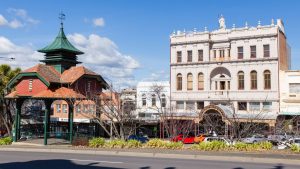Source: Domain.com.au
First-home buyer grants for new builds in regional Victoria on the rise
Jake Seers always thought he’d buy a home in Ballarat. The 24-year-old farmer and agronomist from nearby Clunes says the burgeoning city was the best place for him to balance work and family life.
“I’ve always wanted to be close to the farm. Ballarat is about 30 minutes away, it’s got a lot of things going on and is growing rapidly at the moment,” Mr Seers says.
Though he had saved a $20,000 deposit for his first home, he was concerned rising house prices might mean less bang for his buck.
“It took me a long time to save the deposit,” he says. “I wanted to buy something that was more of an investment, not just for me to live in for five years.”
Mr Seers is one of the 2440 first-home buyers who have taken advantage of the state government’s doubling of the first-home buyer grant for new builds in regional Victoria in the past year.
The grant was increased to $20,000 in July last year, encouraging an extra 1408 people to build a new home in 2017-18, up from 1032 the year before.

Further stamp duty concessions introduced in 2017 have also boosted first-home buyer numbers in regional Victoria, with 7915 not paying stamp duty and 274 paying reduced stamp duty last financial year, compared with 3581 receiving the 50 per cent reduction offered the previous year.
GJ Gardner Homes Ballarat director Rob McMaster has seen more first-home buyers from Melbourne and overseas building in Ballarat in the past year. He puts it down to the government incentives.
“There’s still plenty of well-priced land, and overall people can get into a really good home for a lot less than what they can in the suburbs of Melbourne,” Mr McMaster says.
But Grattan Institute chief executive John Daley says while the scheme encourages some people to move to regional areas, it’s not enough to make any difference to Melbourne’s population and housing affordability struggles.
“The number of people who move to regions as a result of these kind of grants is tiny,” Mr Daley says. “Melbourne is growing by 127,000 people per year, and as a result of this policy, we’ve had 1400 first-home buyers build in all of Victoria’s regions.”
He says first-home buyer grants are not helpful to buyers because they are often paying more than they would have in the long term.
Entry level house prices in Victoria’s regional centres have significantly increased since grants and concessions were introduced – with the two largest, Geelong and Ballarat, recording double-digit year on year growth, according to Domain Group data.
In Shepparton and Warrnambool, where prices were previously in decline, entry level medians have shot up by 5.7 and 4.4 per cent, respectively, in the year to June 2018.
Wodonga has also seen substantial growth, with both entry level and overall median house prices growing by more than 8 per cent.
Tom Sanderson from Wodonga Real Estate says first-home buyer activity was partly to thank for the rise in prices, but that investors were also looking to the area.
“People are coming from the cities — Melbourne, Sydney and Canberra — to take advantage of the stable market, low vacancy rates and good rental returns,” Mr Sanderson says.
Median house prices in regional centres, while still growing, are starting to reach their peak, Domain Group data scientist Nicola Powell says.
“But when you have a look at the entry price, it’s a different picture – it’s still growing at an extraordinary rate, and I expect the level of growth will be higher in the next quarter,” she says.
Mr Daley says grants usually made prices spike in the short term, and then return to a “normal” level of growth after about six to 12 months.
He said to make a more substantial difference for first-home buyers, Melbourne and Victoria needed more medium density development in areas with public transport infrastructure.
“It’s another 20,000 to 25,000 dwellings a year – that’s the kind of magnitude that you need. An extra 1400 dwellings is just not big enough to move the dial.”
Treasurer Tim Pallas says the grants are encouraging young people to stay in regional areas, rather than moving to Melbourne to build their first home.
And for Mr Seers, the extra $20,000 has meant exactly that.
“You start to realise that you’ve achieved something that a lot of people are struggling with. It is a really good feeling – it’s something you own so you’re pretty proud of it,” he says.
